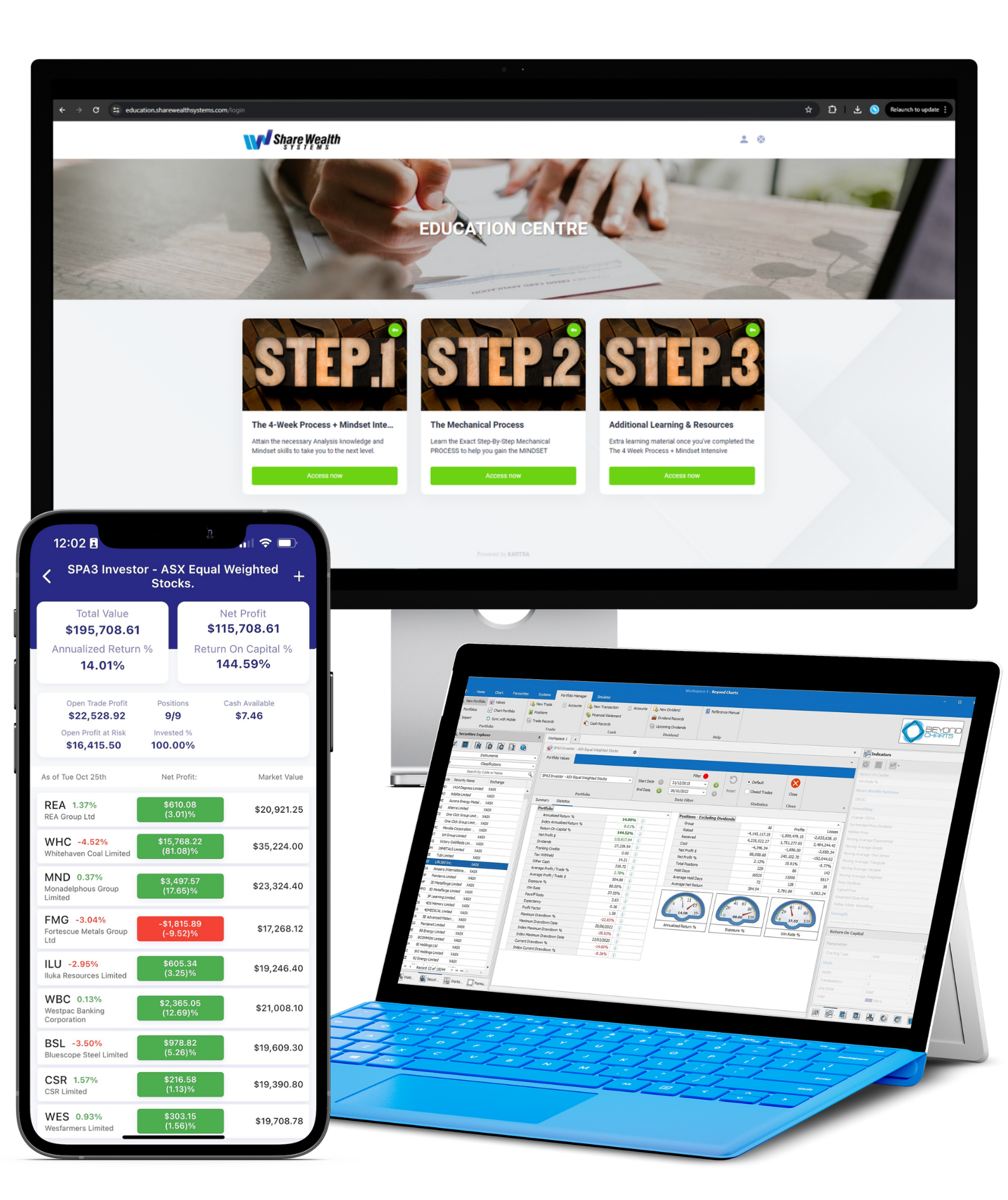
If you don’t have a Decision Support System (DSS) to guide your investing actions, you’re flying blind.
And making impulsive on-the-fly decisions based on noise and other random, completely unstructured “variables.”
Doing this will get you or, more precisely, your profits killed in the long run.
Eventually, and probably sooner rather later, the market will do something where you just won’t know what to do.
And the on-the-fly decision you make will turn out to be a huge mistake, a potentially irrecoverable error.
To become a consistently profitable investor, you must have a well-defined system for making ALL your investment decisions, in a timely confident manner.
Not any system will do the trick, of course. In fact, some of the most popular DSSs will actively work against you. And yes, there are countless DSSs to choose from in the investing space.
But they can all essentially be grouped into 3 types.
Today I’ll break down the pros & cons of each. And help you decide which type to use based on your current investing skills and situation.
Okay, let’s dig into it:
Type 1: Subjective Decision Support System
If we were to cling to formal definitions, a DSS can’t be subjective. That’s because it’s a “computerized program, or engine, used to support determinations, judgments, and courses of action for an organization or business.”
There’s no computer or engine when using a subjective “DSS” because it needs unambiguous instructions. Even AI does. Heck, you don’t even have a DSS.
Instead, YOU are the DSS.
Okay, my disdain for the subjective DSS is obvious by now. So yes, I’m biased.
But I daresay this bias is well-founded in facts and seeing this type of DSS kill way too many investors’ profits and emotional well-being.
You see, when you use your conscious mind as a DSS, you’re basically relying on lots of different input it takes in from your emotional and internal knowledge. Plus, through your senses from the surroundings (e.g., newsletters, chart analysis, media, emails, brokers, Google searches etc.).
Based on such input, your mind subjectively “computes “which stocks to buy, hold and sell in a portfolio, and when.
On the surface, it might seem to you (as does to the many using this DSS) there are rules behind such decision-making. But the reality is there aren’t.
At least not structured ones. Instead, you have loose “rules” you can override at any time your cognitive mind sees fit. And for any reason the “circumstances” dictate.
Sure, you may do very well with this approach if you have years of stock market experience (more on that later). But you can also perform horribly.
When you use a subjective DSS, you embark on a journey to see how in tune your mind is with the way the market ticks. So, if the two minds don’t sync well, you’re in for a bumpy ride…
And will never achieve consistent and sustained success.
Most investors use a subjective DSS. Which is, IMO, why most investors fail to become consistently profitable.
You can’t achieve consistency with a haphazard approach. At least not without suffering through many formative years of losses and emotional turbulence first.
Type 2: Mechanical Decision Support System
If you read any of my articles, posts, etc., you know I’m all for having a mechanical investing system that uses a clear-cut, on-off algorithm. With rules and criteria you follow without fail.
Yet once again you can’t call this a bias. Because it’s based on facts.
A mechanical system’s very purpose is to destroy biases. And ever since the 1980s, experienced traders have used it for just that:
To overcome their personal baggage, emotions, innate human heuristics, and external opinions with their buying and selling decisions.
When you make investment decisions via a mechanical DSS, you have a carved-in-stone, rules-based system. These well-defined and unambiguous rules are 100% objective…
And designed to overcome emotion, subjectivity, innate human heuristics, and hearsay discretion.
In fact, there’s just one input in this type of DSS:
What, when and how much to buy, and when to sell are all computed by the DSS. In accordance with pre-researched and defined rules applied to the price action data.
By definition, this makes a mechanical DSS a consistent, objective, structured, unemotional, and organized way to invest.
There are no guarantees of success, of course. But unlike a Subjective DSS, you know the probability of success in advance. The probability is defined by researching historical price action until you have a good enough Edge and is therefore known from the get-go of your trading.
Another “cool” thing about a Mechanical DSS is you can start using it instantly. Without years of trial-and-error live-trading and gaining market knowledge.
That’s because said knowledge is ingrained in the DSS. More specifically, it’s “learned” through research and back-testing. Which is then programmed into the DSS.
It’s this knowledge that allows you to synchronize with the market.
It won’t be a perfect sync, sure. But its profits will be often enough and big enough to lay the groundwork for consistent and sustained success.
To understand what I’m saying, you must see the market as a probabilistic, not perfect environment. One with an endless stream of uncertain, highly profitable opportunities that have a probability of < 1 of success.
A mechanical DSS has a pre-researched Edge with a probability of <1 in your favor to take advantage of some of these opportunities. The better the Edge, the closer to 1 you get.
In a nutshell, a good mechanical DSS can stack the odds in your favor in the long run. And make the market’s uncertain environment much easier to navigate.
Because all you need to do is follow the rules – and long-term profitability will come.
The game of roulette has an Edge of 0.0526 in favour of the House.
Type 3: Intuitive Decision Support System
This is basically a subjective DSS “on steroids.” That’s because once again you’re the DSS.
Except in this case, you have a wealth of experience and investing skills under your belt. And aren’t constantly changing the basis for your decisions.
In other words, you invest with your subconscious instead of your cognitive mind. You’re using your intuition and “street smarts” to decide what and when to buy and sell, and what not to buy.
Many investors mistakenly believe they’re using an Intuitive DSS when in fact they’re using a Subjective one.
You can’t just wish this sort of transition into existence. It takes decades of experience, trial-and-error, winning and losing, and slowly in a time-grown manner honing your stock market gut-feel and intuition to make it.
Even the few investors who get to this level used a Mechanical DSS as a stepping stone. And then intertwine it with their cultivated experience.
Over time, their subconscious mind syncs with the market at a similar enough wavelength to be consistent and objective. They develop a peripheral sense and vision to be able to “see,” “feel,” and “hear” the market.
Sounds amazing. But, as I’ve said, it takes decades of hard work (and financial/emotional loss) to get there.
Hence, nary a few investors actually have an effective Intuitive DSS.
Which DSS Should You Use?
If you read this article carefully (or any of the others I’ve written), it’s clear I’m in the Mechanical DSS “camp.” And would recommend it to anyone, despite their investing skills or stage in their investing journey. At least for some of their investable capital.
It’s not just me who’d make such a recommendation, of course.
People like Ray Dalio, Mark Douglas, Michael Covel, etc., have been “advocating” for mechanical investing for years & decades.
Still, I wanted you to see all options out there and then decide for yourself. So, let’s put my opinion aside for a moment and rehash the facts. Which all come together to this line:
You can’t pre-research and back-test subjectivity or intuition.
There’s no way to state with 100% certainty what your subjectivity or intuition would have decided to do 10 years ago.
Consequently, you can only future-test to discover if your subjectivity or intuition have an Edge over many future real-time trial-and-error decision-making buy/sell events. This would take many years, and you putting real money on the line.
On the other hand, you can, with the right knowledge, easily back-test and pre-research historical stock price data. And use the findings to create a Mechanical DSS with an Edge that puts probability on your side.
Then, if you want, you can become a successful intuitive investor down the line. But the first step is always a mechanical DSS.
Same goes for other facets of life. Take driving a car, for example:
First, you had to consciously think where you were looking, putting your feet, and placing your hands. You had poor peripheral vision and hearing because all your focus went on the mechanical actions.
Then, eventually, all those things become intuitive.
It’s the same with trading. Except it takes years & decades to get there, as I’ve mentioned. That’s because there are many more variables at play in varying timeframes. And hence many more negative outcomes.
Still, no matter what I or any other (real) expert says, at the end of the day most people will continue using a Subjective DSS. People’s ego’s and pride get in the way, which makes them highly un-coachable.That’s just how things are.
But if you aren’t one of those people…
And agree having a mechanical DSS backed by a verified and pre-researched Edge is your best bet for outperforming the market and reaching your long-term financial goals…
But have no idea how to develop or find a reliable one to use, nor how to build a mindset to actually execute such a Decision Support System …
These articles may help get you started:
- How To Become A Peaceful & Profitable Investor
- 7 Essential Elements For An Outperforming Stock Market Portfolio
- Why You Can (And Should) Time The Market
- You Shouldn’t Invest A Cent without A Verified Statistical Edge
- Why The Right Trading Mindset Is Crucial For Long-Term Success
Or, you can always send me an email with your investing situation. I can’t offer specific advice. But I can point you in the right direction to find what you’re looking for.\
To your success.


